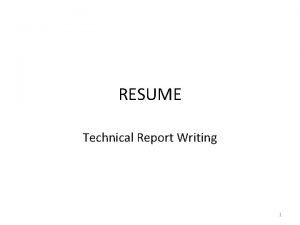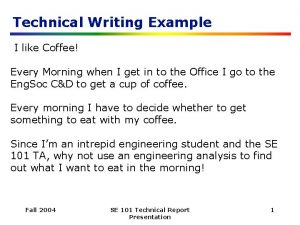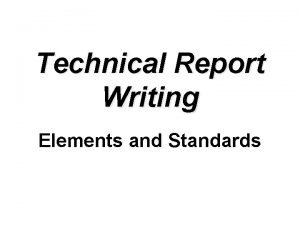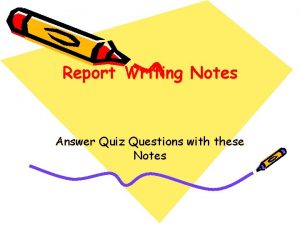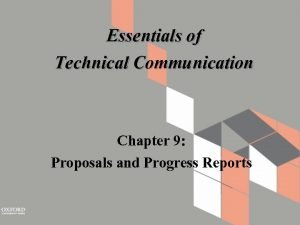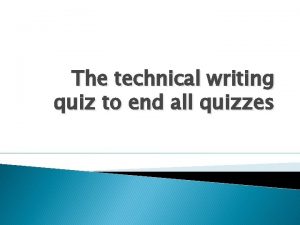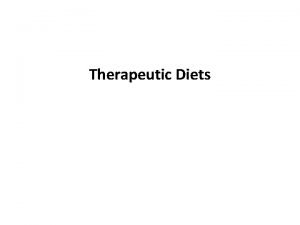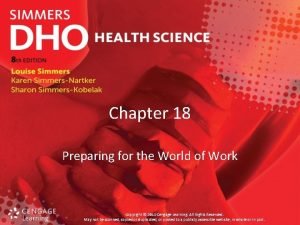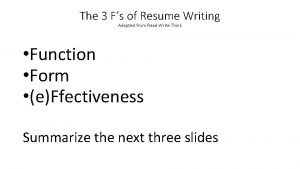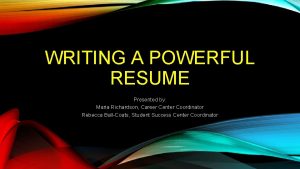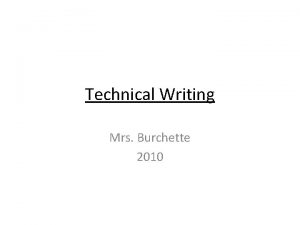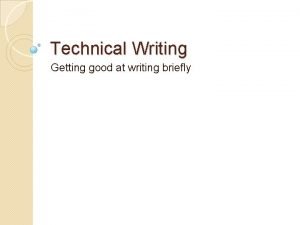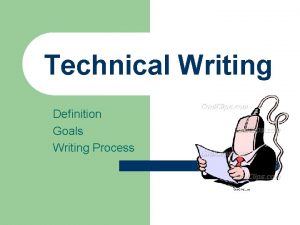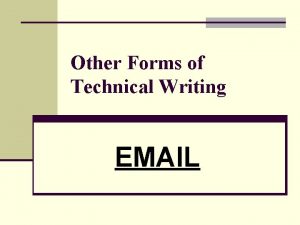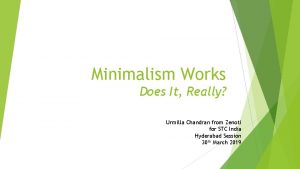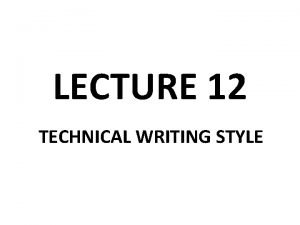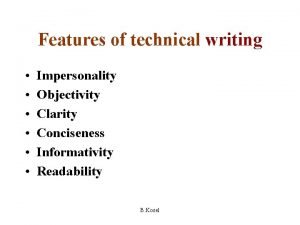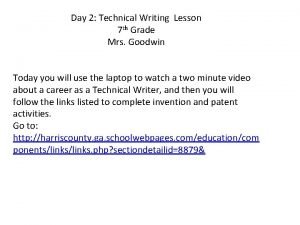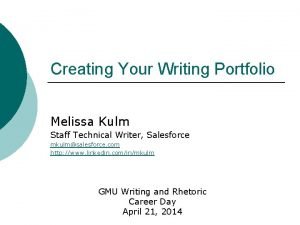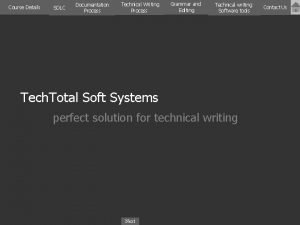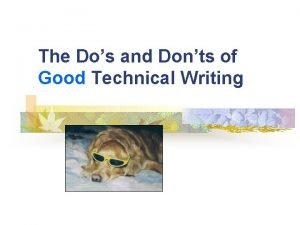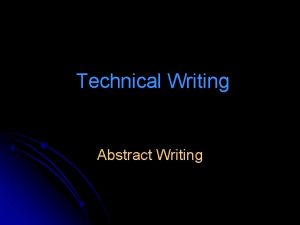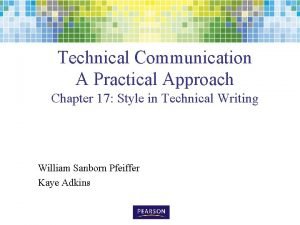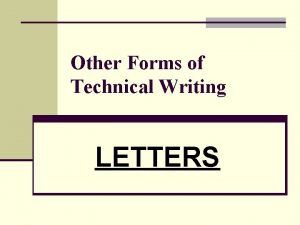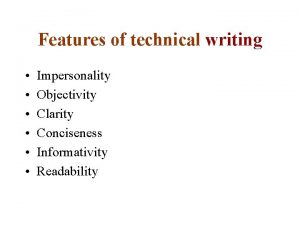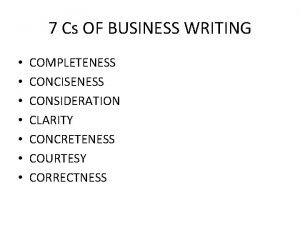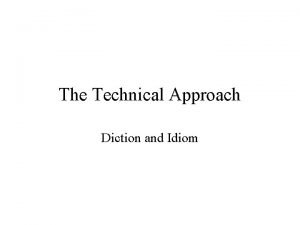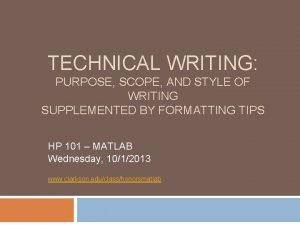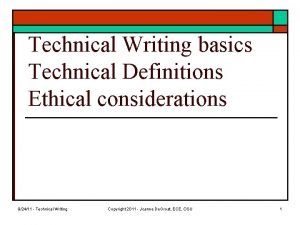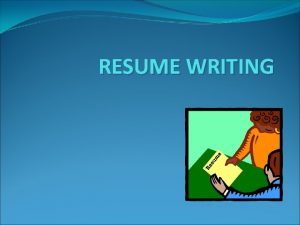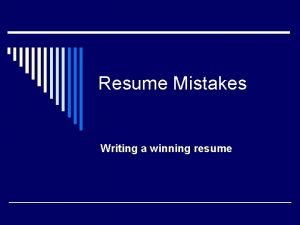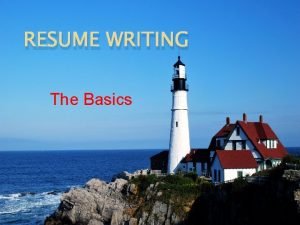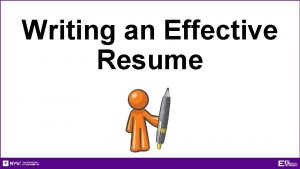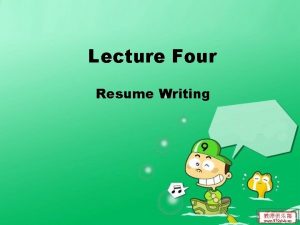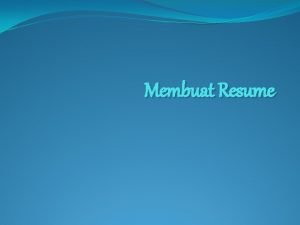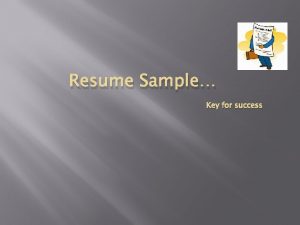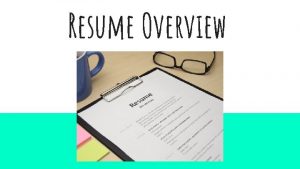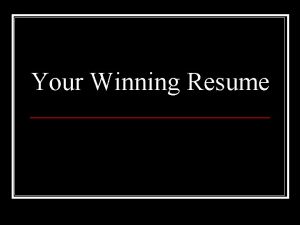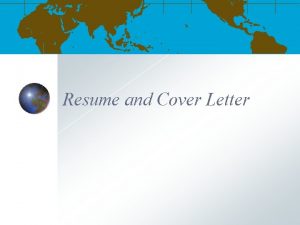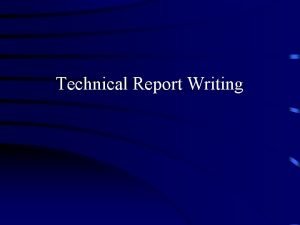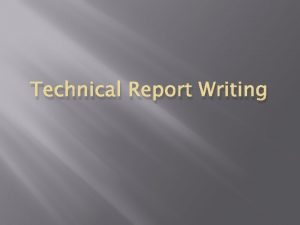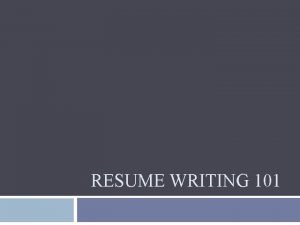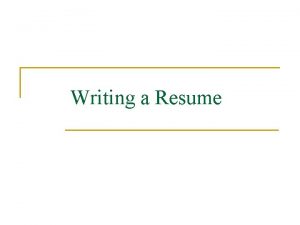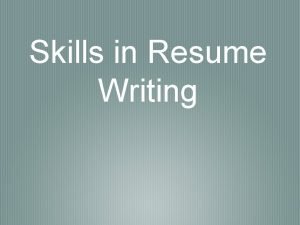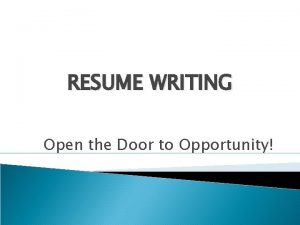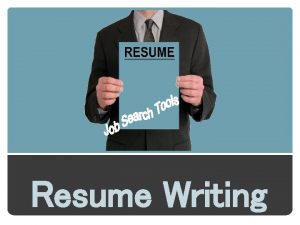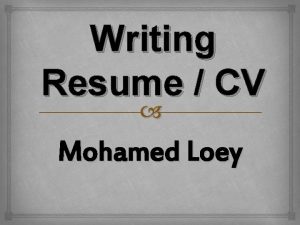RESUME Technical Report Writing 1 Resume How to



































- Slides: 35

RESUME Technical Report Writing 1

Resume • How to write a resume. • Criteria of writing an Effective Resume • Optional Resume components. 2

• Resume / Cover Letter Writing • Resume and cover letters are key tools for a job search. It’s essential that you perfect your business documents to be successful. • Writing A Resume • A resume summarizes your education, experience, and skills related to your career goals and objectives. It is important that your résumé highlights your accomplishments, identifies your strengths, and is tailored to the position and/or industry you are pursuing. 3

• • Types of Resumes Chronological Resumes Functional Resumes Combination Resumes 4


• Chronological Résumés • Before you begin constructing your resume, remember that organization, style, format, content should reflect you in the most positive manner. Above all else, you should be happy and comfortable with your resume, so make sure you are proud of what you send out to employers. What is a Chronological Résumé? • The chronological resume is the most traditional type of resume. The employment section is arranged so that the most recently held position is listed first. The jobs then are listed in reverse chronological order, ending with the oldest position. Each position should include the name of the organization, city and state, job title, dates of employment. Following this information, job duties performed, skills used, and accomplishments made. Advantages to Chronological Résumés • This résumé format is easily recognizable by employers and highlights individual work experiences. 6




• Functional Resumes • Before you begin constructing your résumé, remember that organization, style, format, content should reflect you in the most positive manner. Above all else, you should be happy and comfortable with your résumé, so make sure you are proud of what you send out to employers. • What is a Functional Resume? • The functional resume highlights the skills and abilities that you have gained not only from your work experience, but also any other activities and involvement. This format does not focus on detailed descriptions of positions, but on accomplishments and skills you have acquired. Experiences and places of employment with dates are listed in a separate section of the résumé. If you have gained skills that would be easily transferred to the position for which you are applying, the functional résumé might be the right format. • Advantages to Functional Resumes • This resume format highlights your skills in a targeted fashion toward a desired position, is easy to read, and doesn’t draw attention to a lack of or gaps in employment history. 10



• Combination Resumes • Before you begin constructing your résumé, remember that organization, style, format, content should reflect you in the most positive manner. Above all else, you should be happy and comfortable with your résumé, so make sure you are proud of what you send out to employers. • What is a Combination Resume? • The combination résumé includes both a detailed chronological listing of individual work experience and a section briefly describing skills or competencies. • Advantages to Combination Resumes • The format is easily recognizable to employers, details the duties for each position held, and includes a summary of your transferable skills. This is an attractive option for students who like the structure and organization of the traditional résumé while including a summary of qualifications. 13



• Resume Organization & Content • A résumé summarizes your education, experience and skills related to your career goals or job objectives. Before you begin constructing your résumé, remember that the organization, style, format and content should reflect on you in the most positive manner. • It is important that your résumé highlight your accomplishments, identify your strengths and abilities, provide an outline for an interview, and be tailored to the position and/or industry you are pursuing. • Resume Organization: Sections • The following are sections commonly included in résumés. Click on the section name to read specific advice on what information to include and view samples. These are typical headings but not the only ones you can include. Use them as guidelines in developing a first draft of your résumé. • Resume Tip #1 • Be sure that employers can easily identify your academic, work and related experience with clearly visible section headers. Bold print, capital letters and underlining are ways in which to emphasize your sections. 16

• • • Standard Resume Components Name and Contact Information Education Work Experience Optional Resume Components Summary of Qualifications Professional Affiliations Community Service and Activities Honors and Awards Skills References 17

• Standard Resume Components • Name and Contact Information • Begin your résumé with your basic contact information with your name at the top of the page. Please be sure your address, email and phone are current as this is where the employer will reach you to arrange an interview. • Resume Tip • Your name should be the largest item on your résumé and is typically 2030 size font. You may also want to arrange your contact information underneath in a way that resembles a page header that can be used on other business correspondence like cover letters, thank you letters, etc. 18

• • • What to include Your name (should be the most prominent feature on the page) Local and/or permanent address (where an employer can send you mail) Local, permanent and/or cell phone number (where you are prepared to accept employer phone calls) Your e-mail address (one you will check regularly) What not to include Photographs, hobbies, personal interests, or other personal information such as age, height, gender, race, or marital status. Inappropriate email address (i. e. beachblondie 42@yahoo. com or squirrelchaser 98@hotmail. com) Phone number linked to an inappropriate voicemail message. Make sure to check what people are hearing when they call you! Remove the hyperlink from your email address when you type it in, otherwise it prints in blue ink.

• Good Example • Career Specialist MU Career Center, University of Missouri • January 2015 – Present Columbia, Missouri • Educated students about effective job search strategies including résumé writing, interviewing, networking and salary negotiation. • Participated in over 100 hours of training and continuous professional development in areas such as customer service, career coaching techniques, and career topics. • Facilitated 18 career workshops, 50 minutes in length, for groups of 10 -100 students on topics such as résumé/cover letter writing, interviewing, and the Strengths Quest assessment. • Poor Example • Career Specialist, University of Missouri-Columbia • I met with lots of different students to help them with their résumé writing and interviewing. A ton of them came to a workshop I held where I talked about different tips on job searching. Did training. 20

• Good Example • Sample Student • 165 University Avenue Columbia, MO 65202 555 -5555 student@mail. missouri. edu • Poor Example • Sample Student 165 University Avenue Columbia, MO 65202 555 -5555 ilovechocolatecake@gmail. com Profile: Single male undergraduate who likes to read and watch scary movies. 21

• Work Experience • This section is typically the largest part of the résumé, depending on the extent of your experience. It will provide details of your employer, the positions you held, and your achievements. • Resume Tip • Unsure of your job title? You should contact your supervisor to discover the name or select a job title that captures the level of responsibility for the position you held. • What to include • Job title, employer name, city and state, and dates of employment (list most recent jobs first and work backwards in time). 22

• Describe each job in a way that clearly highlights relevant skills. This can be done through several short concise statements that begin with a past tense action verb and are set apart from the rest of the text by bullets. You should also use high impact adverbs and qualifying adjectives • Detail your experience as it relates to the position or field of interest and put the most important and relevant duties first. • Quantify when possible (e. g. , supervised a staff of 10, increased sales by 15%, handled up to $15, 000 daily, etc. ). • Use alternative headings, if necessary, to separate experience that is most directly related to your objective. Examples include: Computer Experience, Sales Experience, Financial Experience, or Writing Experience.

• • • ü ü ü What not to include Paragraphs. Your history should be in bulleted format so the employer can quickly scan your work history. Short, vague statements. Be as specific and descriptive as possibly while still being concise. Personal pronouns such as “I”, “we”, “me”. It is implied that you did these things so start bullets with verb. Negativity. Everything should come across as positive and productive, even if you didn’t like your job. Possible section titles Professional Experience Related Experience Internship Experience Clinical Experience Specific name of experience (Management Experience, Writing Experience, etc) 24

Education • This is the section where you outline your particular degree program(s), what school you attend /graduated from, and the year you graduated/are graduating. There is some optional information you may include depending on your field such as GPA, relevant coursework, and accomplishments. This section is typically located near the top of your résumé for new graduates. 25

• • Résumé Tip #3 Do you know the exact name of your degree program? • • • What to include The name of the university, city, and state Your degree and major, date of graduation (month & year) or expected date of graduation (click here for the list of MU degrees so you have the exact degree title!) Minor and/or areas of concentration Optional: GPA, cumulative and/or that of major if it reflects well on you (typically a 3. 0 or higher) Optional: Relevant coursework that you feel will add to your qualifications Optional: Other colleges you have attended where you obtained a degree Optional: Accomplishments (i. e. , financed 80% of education through…, consistently worked 20 -25 hours per week while full-time student, graduated in four years, etc. ) Optional: Study abroad including name of school, location (city and country), and time overseas • •

• What not to include • Abbreviated terms. Make sure to spell everything out (i. e. Bachelor of Arts in Communication instead of BA in Comm. ) • High school information if you are seeking a post-secondary education or training. Freshman will have to include such information. • Incorrect degree information. Make sure to look up your degree online to get correct wording • Every class you ever took in the degree program. If relevant, you may include several classes but don’t let it overwhelm the page. • If you have transferred several times, just include the school from which you are graduating/graduated from. • Possible section titles • Academic Background • Academic Training • Degrees Earned • Education 27

• Good Example • University of Missouri Columbia, Missouri Bachelor of Arts in Psychology, minor in Philosophy Anticipated Graduation Date: May 2017 Cumulative GPA: 3. 45/4. 00 • Poor Example • MU BS Philosophy, 2009 GPA: 2. 3 28

Optional Resume Components • Summary of Qualifications • The summary of qualifications can appear near the top of your résumé and summarizes your education, experience and/or skills. The summary of qualifications, like the objective, gives your résumé focus and direction. It can be used instead of an objective or may be used to compliment and support an objective. • Resume Tip • For many undergraduates, a Skills section is a better option to identify desirable attributes rather than a Summary of Qualifications since many students lack extensive work or related experience. • What to include • Statement(s) of breadth or depth of experience • Relevant educational background • Skills practiced and/or developed • Tailored statements that parallel your skills or experience directly to the job listing 29

• • What not to Include Irrelevant information. Make sure the qualifications listed match well with the job for which you are applying. Vague information. Be as specific as possible. More than five bullet points, generally. You have the rest of your résumé to explain in greater detail… remember, it is a summary. Possible section titles Summary of Qualifications Profile Professional Highlights Professional Qualifications Competencies 30

• Good Example • SUMMARY OF QUALIFICATIONS • Experienced in design for print publications and web sites. Proficient in Adobe In Design, Photoshop, HTML, and Quark. Education with emphasis in design, general fine arts, and marketing. Able to communicate well with clients and meet deadlines. Poor Example • SUMMARY OF QUALIFICATIONS • Enjoy design. Know various computer software programs. Completed Art 3226, Sculpting 1340, Marketing 1010 courses. Good Communicator. 31

Professional Affiliations • You may create a separate section that highlights some of your memberships and connections with professional groups, especially if you have been an active member. Resume Tip • Think about joining associations as they are a great way to network with professionals in the field. Many professional associations have student memberships at low or no cost! • • • What to include The name of the organization spelled out in its entirety. Leadership positions you have held within the organization. Optional: Years of your membership (2016 -2017). Optional: Committees you have served on. Optional: A brief description of the organization if not recognizable to most employers. 32

• What not to include • Abbreviated terms. Make sure to spell everything out (i. e. American Psychological Association instead of APA) • Possible section titles • Professional Affiliations • Associations and Memberships • Certification & Licensures • Professional Activities 33

• Good Example • Student Member, American Chemical Society Student Affiliate (ACSSA) 2015 -2017 Vice-President, Alpha Chi Sigma – Delta Chapter (Chemistry fraternity) 2016 -2017 • Poor Example • ACSSA, 2015 -Current ACS, Vice-President, 2016 -2007 34

• Writing a Cover Letter • A cover letter tells the employer what type of position you are seeking and explains your objective. Cover letters entice the employer to learn more about you by reading your résumé and can impress the employer by showcasing your knowledge about the company and its goals. Cover letters are also a great tool to show the employer your communication skills 35
 What isresume
What isresume Resume report writing
Resume report writing Technical report writing examples
Technical report writing examples Elements of technical report writing
Elements of technical report writing Report writing quiz answer key
Report writing quiz answer key Essentials of technical communication
Essentials of technical communication Technical writing quiz
Technical writing quiz Technical writing
Technical writing Liquid diet chart
Liquid diet chart 18.1 preparing for the world of work
18.1 preparing for the world of work What are the 3fs in cover letter
What are the 3fs in cover letter Maria richardson font
Maria richardson font Vocabulary technical writing
Vocabulary technical writing Characteristics of technical writing
Characteristics of technical writing Technical writing
Technical writing Abcs of technical writing
Abcs of technical writing Minimalism in technical writing
Minimalism in technical writing Technical writing style
Technical writing style Recency objectivity relevance conciseness
Recency objectivity relevance conciseness Technical writing lesson plans
Technical writing lesson plans Technical writer portfolio example
Technical writer portfolio example Sdlc technical writing
Sdlc technical writing Communication abstract example
Communication abstract example Technical writing dos and don'ts
Technical writing dos and don'ts Conciseness & style
Conciseness & style Abstract in technical writing
Abstract in technical writing Style in technical communication
Style in technical communication Professional letters
Professional letters Abc format technical writing
Abc format technical writing Objectivity in technical writing
Objectivity in technical writing Inquiry letter technical writing
Inquiry letter technical writing Completeness examples in 7cs
Completeness examples in 7cs Diction of technical writing
Diction of technical writing Scope of writing
Scope of writing Parenthetical definition examples
Parenthetical definition examples Example of technical writing poem
Example of technical writing poem

